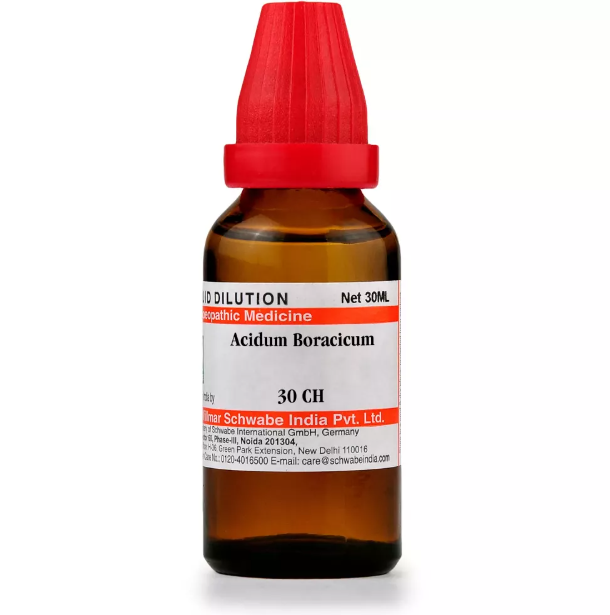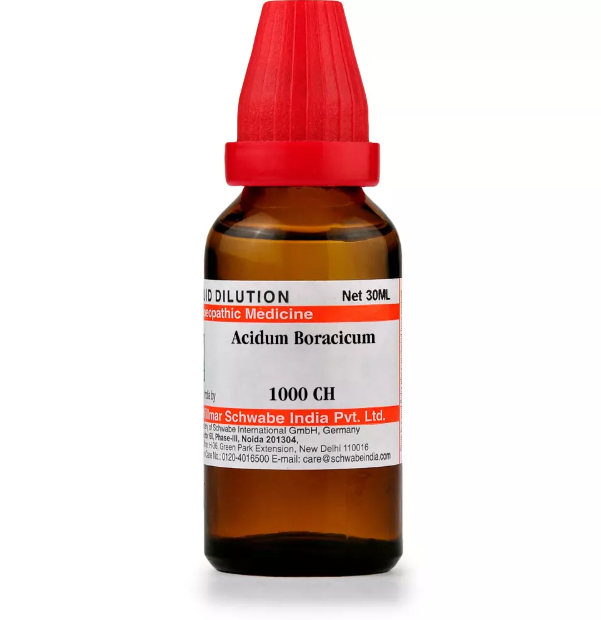BORICUM ACIDUM Q, 6C, 12C, 30C, 200C, 1M, 10M USES AND SYMPTOMS
 Boricum Acidum
Boricum Acidum
(Boracic Acid)
Indications: Used as an antiseptic disinfectant, effective in halting fermentation and putrefaction.
Urinary Tract: Presents with pain in the ureter region, coupled with frequent urges to urinate. Coldness experienced. Diabetes may be concurrent, with a dry, red, and cracked tongue, along with cold saliva.
Female: Climacteric flushings (Lachesis and Amyl-nitrite). It also alleviates discomfort associated with vaginal coldness, akin to feeling packed with ice, and assists in easing frequent micturition accompanied by burning sensations and tenesmus.
Skin: Multiform erythema affecting the trunk and upper extremities, along with exfoliating dermatitis. Additionally, it aids in reducing edema of tissues surrounding the eyes.
Non-homeopathic Uses: Boric Acid serves therapeutic purposes beyond homeopathy. For instance, it is beneficial in cases where the diplococcus of Weichselbaum is present in sputum, as in pharyngitis or bronchitis, as well as in pneumonia with tenacious sputum, hacking cough, and pain. Administered in five grain doses, six times daily, it proves effective. Furthermore, Boric Acid solution, when used as an injection, offers relief in chronic cystitis, or when consumed internally with hot milk. Boro-glyceride, in a solution of 1:40, demonstrates remarkable antiseptic properties. It can also be employed externally in treating styes (15 grains to 1 oz. of water) or as a dusting powder on ulcerated surfaces. In cases of cystitis, it serves as an effective irrigating fluid.
Dosage: Third trituration.
SYMPTOMS OF BORICUM ACIDUM
Female:
Climacteric flushings
Vagina feels cold, as if packed with ice
Frequent urination with burning and tenesmus
Skin:
Multiform erythema on trunk and upper extremities
Exfoliating dermatitis
Edema of tissues around the eyes
Non-homeopathic Uses:
Pharyngitis or bronchitis with Weichselbaum diplococcus in sputum: 5 grains, six times daily
Chronic cystitis: Solution of Bor-ac. as an injection or a teaspoonful in hot milk
Boro-glyceride solution (1:40): Powerful antiseptic
Styes: 15 grains to 1 oz. water for external application
Dusting powder on ulcerated surfaces
In cystitis: As an irrigating fluid
Dose:
Third trituration
selection of the potency
Individualization:
- Homeopathy is based on the principle of treating the individual, not just the disease. The unique symptoms and characteristics of the person are crucial in determining the most suitable potency.
Intensity of Symptoms:
- The intensity of the symptoms guides the choice of potency. If the symptoms are intense and acute, a lower potency (e.g., 6C, 30C) might be considered. For chronic conditions with less intensity, higher potencies (e.g., 200C, 1M) may be appropriate.
Sensitivity of the Patient:
- Some individuals are more sensitive to homeopathic remedies, while others may require higher potencies. The practitioner considers the patient’s sensitivity when selecting the potency.
Acute vs. Chronic Conditions:
- Lower potencies are often used for acute conditions, while higher potencies may be considered for chronic or long-standing issues.
Previous Response to Potencies:
- The patient’s response to previous homeopathic treatments helps guide the choice of potency. If a particular potency has been effective in the past, it may be repeated or adjusted as needed.
Vital Force and Susceptibility:
- Homeopathy views illness as a disturbance in the vital force. The practitioner assesses the patient’s overall vitality and susceptibility to determine the appropriate potency.
Aggravation or Amelioration:
- The direction of the symptom response (aggravation or amelioration) after taking a remedy can influence the choice of potency.
Miasmatic Considerations:
- In classical homeopathy, the concept of miasms (inherited disease tendencies) is considered. The practitioner take this into account when selecting the potency.
Practitioner Experience:
- The experience and preference of the homeopathic practitioner play a role. Some practitioners may have success with certain potencies based on their clinical experience.
SAFETY INFORMATION
- Do not exceed the recommended dose by physician
- Keep out of the reach of children
- Store in a cool dry place away from direct sunlight
- Maintain half an hour gap between food/drink/any other medicines and homoeopathic medicine
- Avoid any strong smell in the mouth while taking medicine e.g. camphor, garlic, onion, coffee, hing
Medicine images use for reference only selection of homeopathic medicine depends on the individual’s specific symptoms and overall constitution. Moreover, homeopathy is a holistic system of medicine that treats the individual as a whole. In addition to addressing the physical symptoms, it takes into account the emotional and mental state of the person. Consequently, it’s crucial to consult with a qualified homeopathic practitioner for personalized treatment.
The information provided on this website is intended solely for educational purposes. Always seek the advice of your physician or other qualified health provider.
